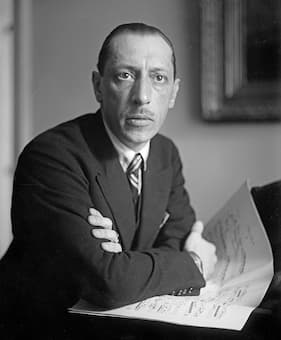
Igor Stravinsky (ca. 1920-30)
Stravinsky’s ballet Le baiser de la fée gives us the life of a child fated to a bad end by a desirous fairy. Composed in 1928 for Diaghilev and created for the prima ballerina Ida Rubinstein, the ballet tells of a small child who is stolen from his mother during a storm and is marked by the Fairy with a kiss; she will return for him when he’s grown, without him knowing what is in store for him.
Hans Christian Andersen’s story of The Ice-Maiden, from which this ballet is evolved, is told from the point of view of the young man and is a far more emotional tale. Stravinsky had a second tale he was telling in this ballet: that of Tchaikovsky.
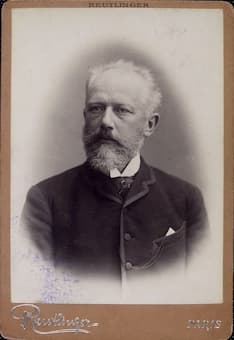
Pyotr Ilyich Tchaikovsky (ca. 1888)
Written for the 35th anniversary of Tchaikovsky’s death in 1893, the Fairy’s Kiss posits Tchaikovsky as the Young Man and the Fairy as his Mephistophelean muse who stole him away from his loving public. Stravinsky had been a long-time admirer of Tchaikovsky, dating from his childhood when he was taken to ballet productions of Tchaikovsky’s work at the Mariinsky in St Petersburg. In addition, Igor’s father, Fyodor, who sang bass in the Mariinsky opera company, also performed in several operas by Tchaikovsky.
The rules that Stravinsky set for himself in creating Le baiser de la fée was that the music had to come from Tchaikovsky’s oeuvre, namely the piano music and songs, and that none of it would have been orchestrated before. He took the analogy from the story that the Fairy’s kiss at the beginning of the opera is the Muse’s/Fairy’s marking of Tchaikovsky from his birth and leaving her imprint on all the music he ever composed.
Stravinsky left a list of Tchaikovsky’s music that he included in his ballet score:
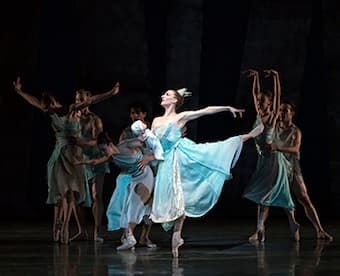
Simone Messmer as the Fairy, Miami City Ballet (2017) (Photo by Gene Schiavone)
Piano music:
Scherzo à la russe, Op. 1/1; Humoresque, Op. 10/2; Evening Reverie, Op 19/1; Scherzo humoristique, Op. 19/2; Feuillet d’album, Op. 19/4; The Mujik plays the Harmonica, Op. 39/12; In the Village, Op. 40/7; Danse Russe, Op. 40/10; Salon Valse, Op. 51/1; Nata Valse, Op. 51/4; Polka peu dansante, Op. 51/2
Songs:
Painfully and sweetly, Op. 6/3; None but the Lonely Heart, Op. 6/6; Winter Evening, Op. 54/7; Lullaby in a Storm (‘Berceuse’), Op. 54/10; Serenade, Op. 63/6
These are fleshed out with passing references to the second movement (Andante cantabile) of Tchaikovsky’s String Quartet, Op. 11 and occasional ‘echoes’ of theme from the symphonies, particularly Symphony No. 5.
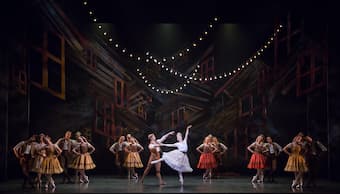
Andrew Peasgood and Bethany Kingsly-Garner in Kenneth MacMillan’s
The Fairy’s Kiss, Scottish Ballet (2017) (Photo by Andy Ross)
However, you will be hard pressed to hear these individual pieces by Tchaikovsky because they are so beautifully assimilated into Stravinsky’s sound. Stravinsky changes tempos, keys, repeated notes, and rhythms. What might be a square sequence in Tchaikovsky becomes asymmetrical and unpredictable in Stravinsky’s hands. As one writer notes ‘Tchaikovsky’s faults – his banalities and vulgarities and routine procedures – are composed out of the music and Stravinsky’s virtues are composed into it.’
The ballet opens with a storm scene, as the Fairy’s attendants find the mother and steal her child. The Fairy kisses the child and then abandons it to be raised by the villagers.
Igor Stravinsky: Le baiser de la fée (The Fairy’s Kiss): Scene I (London Symphony Orchestra; Robert Craft, cond.)
Eighteen years later, at a village fête, the Fairy appears to the Young Man and promising him great happiness, promises to lead him to his fiancée, who was with him just a moment before.
Igor Stravinsky: Le baiser de la fée (The Fairy’s Kiss): Scene II (London Symphony Orchestra; Robert Craft, cond.)
She takes him to the mill where he meets his fiancée and her friends. His fiancée goes off to don her wedding veil and when she reappears, she and the Young Man are married.
Igor Stravinsky: Le baiser de la fée (The Fairy’s Kiss): Scene III (London Symphony Orchestra; Robert Craft, cond.)
But, it is not his fiancée in the veil but the Fairy. He tries to free himself from her embraces, but he is now in her power. The Fairy kisses him again, the fatal kiss, and transports him to a ‘land beyond time and place.’ At the end, the Young Man and the Fairy are resident in the Eternal Palace, and she sings him a lullaby for all time.
Igor Stravinsky: Le baiser de la fée (The Fairy’s Kiss): Scene IV (London Symphony Orchestra; Robert Craft, cond.)

Constance Devernay and Andrew Peasgood in Kenneth MacMillan’s The Fairy’s Kiss, Scottish Ballet (2017) (Photo by Andy Ross)
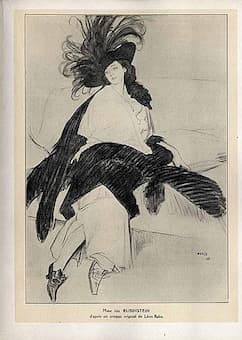
Ida Rubinstein
The choreographer for the ballet was Bronislava Nijinska, younger sister of Vaslav Nijinsky. A dancer and choreographer in her own right, she was initially joyfully received by Stravinsky, but this did not last. Stravinsky was not able to supervise the rehearsals and by the time he did see the final stages, there was a lot he didn’t like. The premiere at the Paris Opera House on 27 November 1928 was not a success – even Diaghilev didn’t like the choreography, although he didn’t give a positive review to the music either.
The work was next produced in 1937 by George Balanchine with the American Ballet and then given in a new version in 1950 by him with New York City Ballet. In 1960, Kenneth MacMillan did a version for The Royal Ballet in London. These later versions have maintained a position in the repertoire.
For more of the best in classical music, sign up to our E-Newsletter
